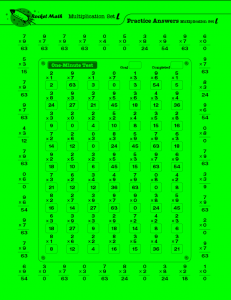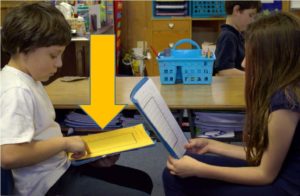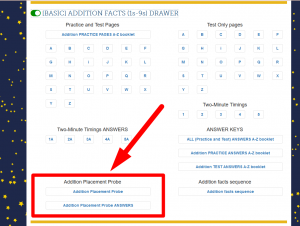 The first question most teachers ask us is about what they have to print out, so we’ll deal with that first. And no, the copyright police will not come and get you. You have a subscription to our virtual filing cabinet so you may print from it. There are three categories of things to print.
The first question most teachers ask us is about what they have to print out, so we’ll deal with that first. And no, the copyright police will not come and get you. You have a subscription to our virtual filing cabinet so you may print from it. There are three categories of things to print.
(1) Print four things for student folders
You must print four things for each student. Three things need to be stapled into or onto each child’s folder (yes, a folder for each child!). So you have to print enough for your class.
- The Rocket Chart (stapled on the front of the folder)
- The Goal Sheet (stapled on the inside left)
- The Individual Student Graph(stapled on the inside right).
 The fourth thing you also have to print but keep it loose in the folder:
The fourth thing you also have to print but keep it loose in the folder:
These first four things are found in the virtual filing cabinet in the Forms and Information DRAWER, under Forms for Every Student.

(2) Print A to Z Answer Key booklets (on colored paper) for every student.

You will have to decide what operation you are going to have everyone start on. Usually Addition or Multiplication, but more on that decision here: With what operation do I start?
The Answer Keys can be found in A-Z booklet form in each Learning Track drawer.

I knew you’d need these in booklet form, so they are already connected together. When you go into the Learning Track look for the Answer Keys. For students working together you want the Practice Answer Keys. When you click on it, the A-Z booklet pops up and you just hit the print button and send it to your printer–after you have loaded some colored paper in the printer.
Print enough booklets (on colored paper) for your class. If you’re really lucky you might have a printer that staples the booklets for you. [Know that you are really lucky!] It will take a bunch of paper but once it’s done you’re set!
Rocket Math does not work if the checkers don’t have an answer key.
In order to be corrected when they are practicing each student’s partner must have an answer key to the page on which they are practicing. Without an answer key, students could practice errors, or get stumped and start trying to count on their fingers or something. Students can’t learn if their partner doesn’t have an answer key to help them.
The answer key has to be in color for you to monitor practice.

See the pair of students pictured above. When you look at them, you know they are doing it right because one of them has a colored answer key booklet and the other doesn’t! When you look out over the students paired up in your room, you need to know that every pair has an answer key out but only one answer key out. When the answer keys are not in color it will be hard to find the problem pairs. But problems will be there, for sure! Some pairs of students will both have answer keys and will be pretending to learn when they are just reading. Other pairs of students will both have problem pages and the checker won’t be able to catch errors. But without colored answer keys you won’t be able to see who is not paired up right. So it is VERY important to make these packets in color. I mean, so important that you should go to the office supply store and get your own personal ream of colored paper if your school does not have it available. It is well worth the $20 or so. Otherwise, it will be a very long year!
You need every student to have their own answer key so they can practice anywhere with anyone at any time.
Here are four examples of issues that make it preferable for each student to have their own answer key, and yes, it should be on colored paper.
1) When students are absent you must pair two students but under the one-answer-key-per-pair both students could be “without” answer keys! In both cases, their partner has the answer key and that folder is in their desk.
2) When someone comes in to help or volunteer, you want Johnny to practice Rocket Math with that person–but Johnny doesn’t have an answer key–his partner does. So Johnny has to go searching for an answer key. If Johnny had his own answer key he could just get out his Rocket Math folder and go to work.
3) The Title 1 or Special Ed teacher or instructional assistant might offer to do extra practice with a student, the student takes his/her folder down to the a place to practice–but doesn’t have an answer key.
4) Alex moves up to division, but his partner doesn’t have an answer key to division–another example where Alex needs his own answer key.
Printing answer keys out in booklet form will save a lot of time and trouble.
This is hard-won knowledge based on experience. It is just a whole lot easier to have these printed out once and distributed once at the beginning of an operation than it is to keep changing to the next answer sheet.
Each of those scenarios above are going to be a problem if you only give students one answer key at a time. You don’t want to have to replace the answer key every time a student moves to another set or level. You don’t want to have students who want to practice but don’t have the answer to the set they are working on. If you make the answer key booklets up, on colored paper, and staple them together they are set until they finish the operation. We have also found that some of those answer key booklets survive and can be used again the following year.
(3) Optional to copy the Placement Probes.
You may need to copy something else to put into everyone’s folder, if you plan to use it:
- The Placement Probes for the operation you are starting. You don’t have to use placement probes, especially if your students are new to memorizing math facts. How you decide when to use the Placement Probes and when not to can be found in the section on “Why would I want to give the Placement Probes?” (How is that for clear?)
If you do want to use the placement probes, you can find them in the virtual filing cabinet under each separate operation. Here’s what they look like in the Addition Drawer.












